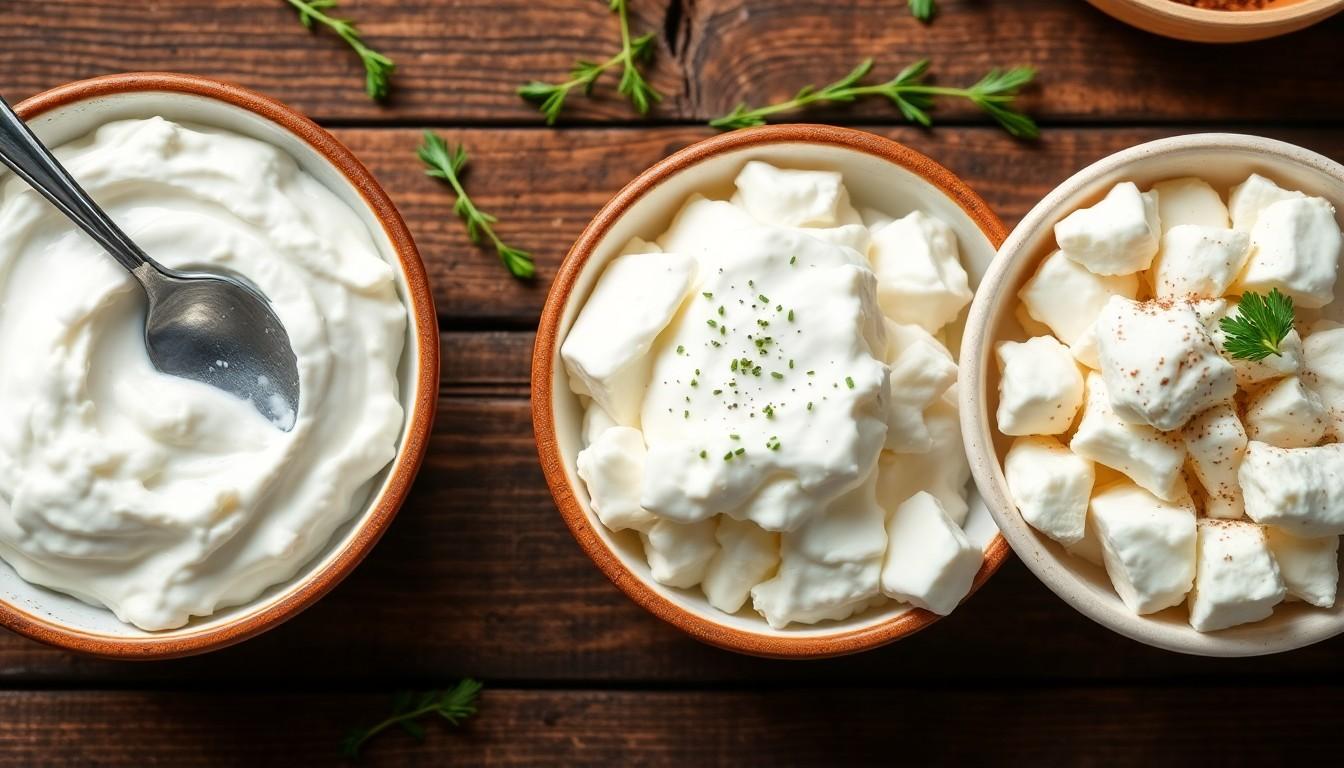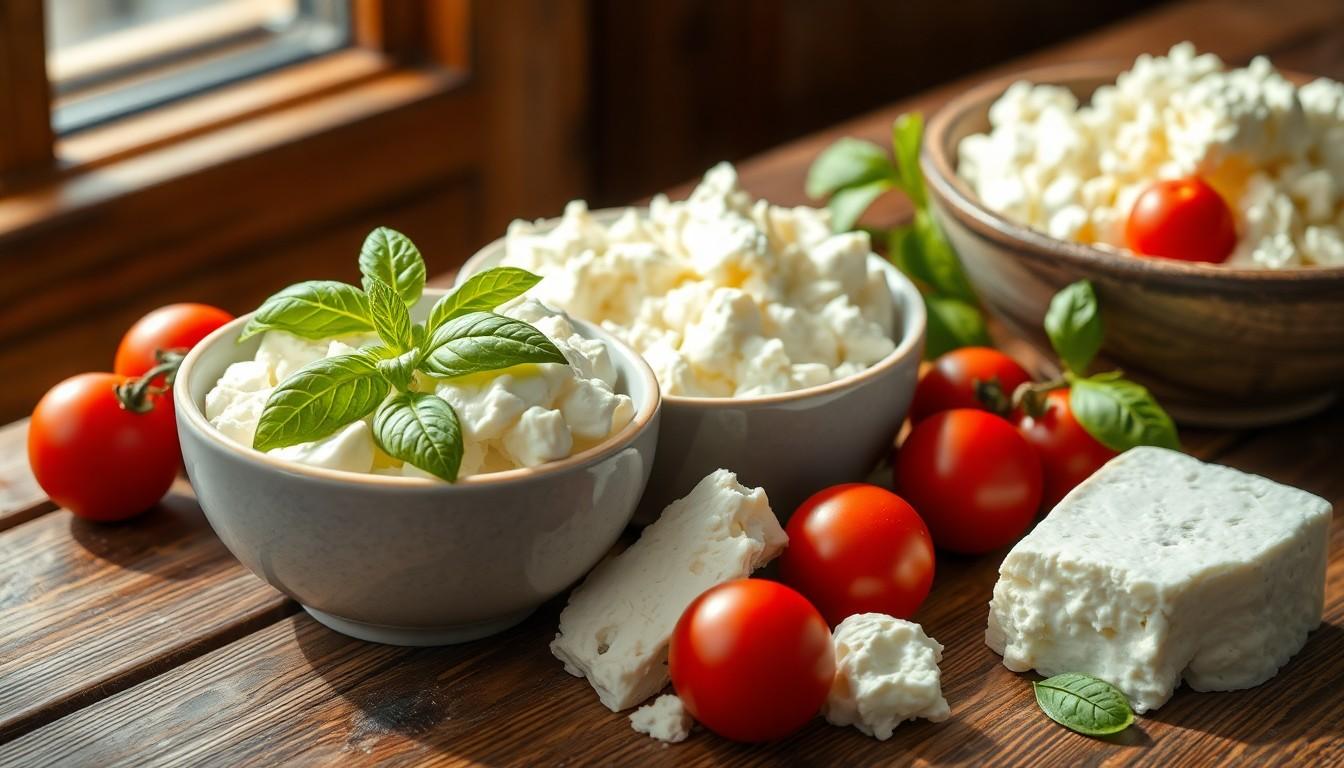When it comes to dairy products ricotta and cottage cheese stand out as popular choices for health-conscious consumers. While these creamy white cheeses might look similar at first glance they offer distinct nutritional profiles that can impact dietary goals differently.
Both ricotta and cottage cheese pack impressive protein content making them excellent choices for muscle building and weight management. Yet their unique production methods and ingredient compositions result in varying levels of calories fat content and essential nutrients. Understanding these differences helps consumers make informed decisions about which cheese better suits their nutritional needs and dietary preferences.
Ricotta vs Cottage Cheese Nutrition
Ricotta and cottage cheese represent two distinct fresh cheese varieties with unique production methods and characteristics. Here’s a detailed look at their origins, production processes, and sensory attributes.
Origins and Production Methods
Ricotta originated in Italy as a whey cheese, utilizing the liquid byproduct from other cheese production. The manufacturing process involves:
-
- Heating whey proteins to near boiling (185°F)
-
- Collecting the resulting curds that float to the surface
-
- Draining the curds in special baskets or molds
-
- Processing within 24 hours of whey collection
Cottage cheese follows a different production path:
-
- Starting with fresh pasteurized milk
-
- Adding bacterial cultures and rennet
-
- Cutting the formed curds into small pieces
-
- Cooking and draining the curds
-
- Washing the curds in cool water
-
- Adding cream dressing to the final product
Texture and Taste Differences
Ricotta features distinctive characteristics:
-
- Smooth creamy texture
-
- Fine granular structure
-
- Mild sweet flavor
-
- Moisture content of 65-70%
-
- Lumpy texture with distinct curds
-
- Wet appearance with visible whey
-
- Saltier taste profile
-
- Variable curd sizes (small, medium, large)
-
- Moisture content of 75-80%
| Characteristic | Ricotta | Cottage Cheese |
|---|---|---|
| Texture | Smooth, creamy | Lumpy, curdy |
| Moisture % | 65-70% | 75-80% |
| Primary Taste | Sweet | Salty |
| Curd Size | Fine, uniform | Variable sizes |
Macronutrient Comparison
The macronutrient profiles of ricotta and cottage cheese reveal distinct nutritional compositions that affect their role in various dietary plans. A 100-gram serving of each cheese demonstrates significant differences in protein, fat, and carbohydrate content.
Protein Content
Cottage cheese contains a higher protein content at 11g per 100g serving compared to ricotta’s 8g per 100g serving. The protein in cottage cheese is primarily casein protein, making it a slow-digesting option that promotes sustained amino acid release. Ricotta’s protein content consists mainly of whey protein, offering rapid absorption and higher concentrations of branched-chain amino acids (BCAAs).
Fat and Calorie Profile
| Nutrient (per 100g) | Ricotta Cheese | Cottage Cheese |
|---|---|---|
| Calories | 174 | 98 |
| Total Fat | 13g | 4.3g |
| Saturated Fat | 8g | 2.6g |
Ricotta cheese contains significantly more fat than cottage cheese, resulting in a higher caloric content. Low-fat versions of both cheeses are available, offering reduced calorie alternatives while maintaining protein content.
Carbohydrate Levels
Both cheeses contain minimal carbohydrates, making them suitable for low-carb diets. Ricotta cheese contains 3g of carbohydrates per 100g serving, while cottage cheese contains 3.4g. The carbohydrate content in both cheeses comes primarily from naturally occurring milk sugars (lactose).
Micronutrient Breakdown
The micronutrient profiles of ricotta and cottage cheese reveal distinct nutritional advantages. Each cheese variety offers unique combinations of essential vitamins and minerals that contribute to overall health.
Calcium and Vitamin D
Ricotta cheese contains 207mg of calcium per 100g serving, while cottage cheese provides 83mg. Both cheeses contain vitamin D, with ricotta offering 0.4mcg and cottage cheese containing 0.1mcg per 100g serving. These nutrients work together to support:
-
- Build strong bones and teeth through calcium absorption
-
- Maintain muscle function through proper mineral balance
-
- Support immune system regulation through vitamin D uptake
Sodium Content
The sodium content differs significantly between these cheese varieties:
| Cheese Type | Sodium per 100g |
|---|---|
| Ricotta | 84mg |
| Cottage Cheese | 364mg |
B Vitamins
Both cheeses provide essential B vitamins in varying amounts:
| B Vitamin | Ricotta (per 100g) | Cottage Cheese (per 100g) |
|---|---|---|
| B12 | 0.34mcg | 0.65mcg |
| Riboflavin (B2) | 0.19mg | 0.28mg |
| Niacin (B3) | 0.12mg | 0.15mg |
| Folate | 12mcg | 27mcg |
-
- Convert food into energy through metabolic processes
-
- Form red blood cells through B12 utilization
-
- Support nervous system function through B-complex interactions
Health Benefits and Uses
Both ricotta and cottage cheese deliver distinct nutritional advantages that enhance various aspects of health. Their versatile nature makes them valuable additions to a balanced diet.
Weight Management
Cottage cheese excels in weight management due to its high protein content and lower calorie profile of 98 calories per 100g serving. The combination of casein protein and minimal fat content creates a satisfying effect that reduces overall caloric intake. Studies from the Journal of Nutrition demonstrate that consuming protein-rich dairy products like cottage cheese increases satiety levels for 4-5 hours after consumption.
Benefits for weight management include:
-
- Prolonged satiety from slow-digesting casein protein
-
- Low calorie-to-protein ratio for portion control
-
- Versatile ingredient replacement in recipes
-
- Compatible with calorie-restricted meal plans
Muscle Building Properties
Ricotta and cottage cheese provide complementary protein profiles that support muscle growth and recovery. Ricotta contains whey protein, which absorbs rapidly for immediate muscle repair, while cottage cheese’s casein protein releases amino acids gradually over 6-8 hours.
-
- Ricotta’s whey protein triggers faster muscle protein synthesis
-
- Cottage cheese’s casein provides sustained amino acid release
-
- Combined consumption optimizes recovery periods
-
- Essential amino acids support lean muscle maintenance
-
- Integration into pre-workout and post-workout meals
| Protein Properties | Ricotta (100g) | Cottage Cheese (100g) |
|---|---|---|
| Total Protein | 8g | 11g |
| Primary Type | Whey | Casein |
| Absorption Rate | 30-60 minutes | 6-8 hours |
| Leucine Content | 0.8g | 1.1g |
Best Ways to Use Each Cheese
Ricotta and cottage cheese offer distinct culinary applications based on their unique textures and taste profiles. Their versatility extends across various dishes, from savory to sweet preparations.
Cooking Applications
-
- Ricotta Cheese Uses:
-
- Fills pasta dishes like lasagna ravioli cannelloni
-
- Creates creamy bases for cheesecakes tarts pies
-
- Blends into dips spreads for crackers bread
-
- Enriches scrambled eggs frittatas quiches
-
- Adds moisture to baked goods muffins pancakes
-
- Cottage Cheese Uses:
-
- Tops salads fruits vegetables
-
- Replaces mayo in tuna egg chicken salads
-
- Creates protein-rich smoothies shakes
-
- Substitutes for ricotta in lasagna stuffed shells
-
- Forms bases for savory dips spreads
Dietary Considerations
-
- Ricotta Applications:
-
- Fits Mediterranean diet patterns
-
- Serves as keto-friendly ingredient (full-fat version)
-
- Adds protein to vegetarian meals
-
- Provides calcium for dairy-free alternatives
-
- Contains lower sodium for restricted diets
-
- Cottage Cheese Applications:
-
- Supports high-protein low-calorie diets
-
- Offers balanced macros for athletes
-
- Functions as post-workout protein source
-
- Adapts to low-carb meal plans
| Dietary Feature | Ricotta (per 100g) | Cottage Cheese (per 100g) |
|---|---|---|
| Keto-friendly | Yes (13g fat) | Moderate (4.3g fat) |
| Protein Content | 8g | 11g |
| Sodium Level | 84mg | 364mg |
| Lactose Content | Low | Moderate |
Nutritious snack
Both ricotta and cottage cheese offer unique nutritional benefits that make them excellent choices for health-conscious individuals. While cottage cheese stands out for its higher protein content and lower calories making it ideal for weight management ricotta provides more calcium and healthy fats that support overall wellness.
The choice between these two versatile dairy products ultimately depends on individual dietary goals and preferences. Whether someone’s looking to build muscle maintain weight or simply enjoy a nutritious snack both options deliver essential nutrients in their own distinctive ways.
Incorporating either or both cheeses into a balanced diet can contribute to better nutrition while adding variety to meals and snacks. Their different textures flavors and culinary applications make them valuable ingredients for countless healthy recipes.
